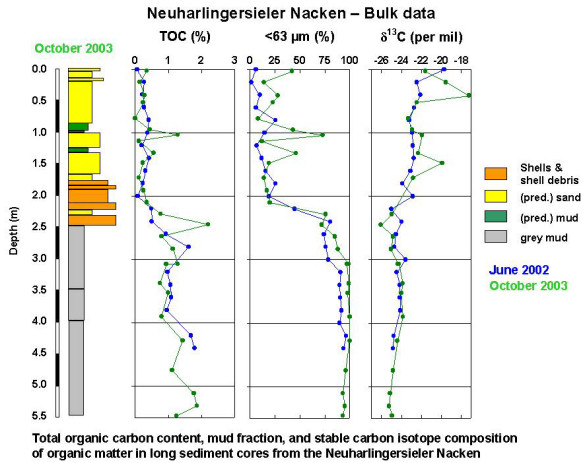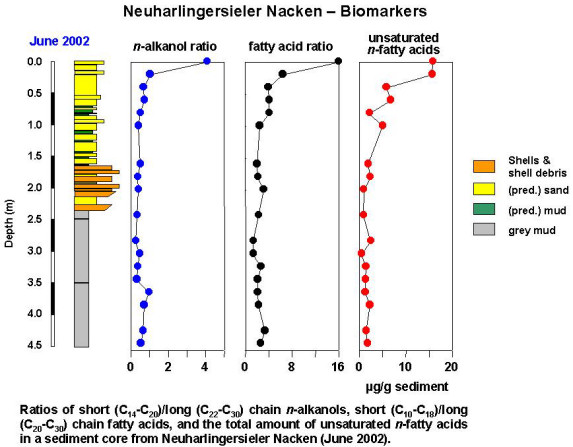
BioGeoChemistry of Tidal Flats
Content, composition and sources of organic matter in deeper sediments layers
Sediments of the Wadden Sea are mainly a composite of sand, mud, and organic matter of different sources. In addition to marine organic matter eroded peat from intercalated peat layers contributes significantly to the total organic matter in the investigation area. Volkman et al. (2000) investigated the composition of the organic matter in sediment cores up to a depth of 90 cm. Very little information is presently available regarding sediments in deeper layers of the German Wadden Sea. The aim of this study is to investigate the content, composition and sources of organic matter in deeper layers of Wadden Sea sediments. Cores up to 5.5 m depth from different locations on the backbarrier tidal flats of Spiekeroog island were investigated.
Sandy and shell-rich sediments of the upper part of the Neuharlingersieler Nacken cores have total organic carbon (TOC) contents of less than 0.5%. Higher TOC values up to 1.3% were found in thin, clay-rich intercalations. In this upper part of the cores the TOC content of the sediments is positively correlated with the percentage of mud (silt and clay fraction <63 μm grain size). Higher TOC values from 0.8 to 1.9 % TOC were found in the lower unit of the cores comprising grey mud deposits (>75% mud). The organic matter in the lower mud unit is predominantly of terrestrial origin. This is indicated by δ13C values of bulk organic carbon of less than 24‰. A relatively higher portion of marine organic matter is present in the upper sand- and shell-dominated interval yielding higher δ13C values between ca. -23‰ and -17.2‰.

A biomarker study of the Neuharlingersieler Nacken core from June 2002 reveals an increasing contribution of terrigenous organic matter with depth suggested by increasing relative proportions of long chain n-alkanes, n-alkanols, fatty acids and C29 sterols in the extractable lipids. In the surface sediment, the marine signal prevails. Accumulations of peat particles at 280 cm and 430 cm depth are responsible for higher amounts of land plant related compounds and elevated TOC values. The depth trends of the individual compound classes (total amounts of n-alkanes, n-alkanols, fatty acids and sterols, respectively) are very similar to the depth trend of the TOC values. As an exception the total amount of unsaturated n-fatty acids rapidly decreases with increasing depth.

In the sediment samples n-alkanes were detected with chain lengths in the range from C19 to C35. All n-alkane distribution patterns exhibit an odd over even carbon number predominance with maxima at the long-chain C27, C29, and C31 n-alkanes. In nearly all sediment samples the C29 n-alkane is the most abundant homologue, whereas the ratio between the C27 and C31 n-alkanes varies. The n-alkanols occur in a carbon number range from C14 to C30 with a strong even over odd carbon number predominance. In the surface sediments the C20 n-alkanol predominates strongly. Other n-alkanols are less abundant and exhibit a preference of short chain homologues.
Fatty acids with 10 to 30 carbon atoms are the dominant compounds in all sediment samples. They exhibit a strong even over odd carbon number preference. Structural classes include saturated and unsaturated n-fatty acids, branched iso- and anteiso-fatty acids (C13 to C17), and ω-hydroxy fatty acids (C16 to C26). The most abundant individual fatty acid in all sediment samples is the n-16:0 fatty acid. In all sediment samples C27, C28, and C29 sterols were detected. The relative proportion of C29 sterols increases with increasing depth.
Relevant publications
- Volkman J.K., Rohjans D., Rullkötter J., Scholz-Böttcher B.M. and Liebezeit G., 2000. Sources and diagenesis of organic matter in tidal flat sediments from the German Wadden Sea. Cont. Shelf Res. 20, 1139-1158
| <<back | All Publications | More details
|